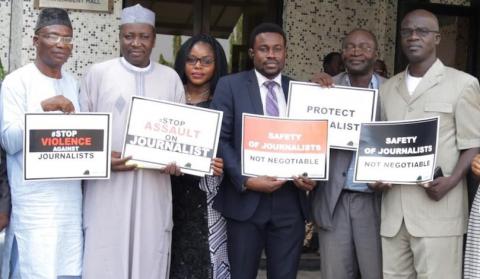- After Supreme Court Decision, Advocates Turn to Technology to Protect Voting Rights – John O'Connor (WNYC)
- Fighting Brutality Against Journalists (TheNEWS)
- Surveillance and Anti-Press Sentiment Heightens Concerns for Journalists Closer to Home – Victoria Baranetsky (Just Security)
- AT&T/Time Warner: The Case Against Monster Bell – Craig Aaron (Moyers & Company)
- How the Web Became Unreadable – Kevin Marks (Backchannel)
After Supreme Court Decision, Advocates Turn to Technology to Protect Voting Rights
By John O'Connor
November 3, 2016 ·
WNYC
Concerned someone might be hindering your right to vote? There's an app for that.
A group of voting rights advocates, attorneys and programmers plan to tap the power of smartphones to track voting issues in battleground states.
The app is called "Cada Voto Cuenta" — Spanish for "count every vote."
Cada Voto Cuenta is a free download, and it uses a phone’s Internet, GPS and video functions to let people record and report possible voting rights violations.
Fighting Brutality Against Journalists
November 5, 2016
TheNEWS
According to Committee to Protect Journalists, Nigeria has failed to prosecute or identify the killers of any of the killed journalists in the past 10 years, just as the country has failed to take action on other forms of impunity against journalists perpetrated mostly by security operatives.
As compiled by CPJ, journalists who have lost their lives in the course of doing their jobs in Nigeria and whose killers have neither been identified or brought to justice include Enenche Akogwu, Channels TV who was killed on January 20, 2012, in Kano and Zakariya Isa, a staff of Nigerian Television Authority, NTA who was also killed on 22 October, 2011.
In recognition of the fact that impunity is one of the greatest threats to press freedom globally, the UN General Assembly passed a resolution in 2013, recognising November 2 as the International Day to End Impunity for Crimes against Journalists.
Surveillance and Anti-Press Sentiment Heightens Concerns for Journalists Closer to Home
By Victoria Baranetsky
November 4, 2016
Just Security
In the United States four journalists reporting on the Black Lives Matter movement were assaulted and detained by police in Ferguson, Missouri. While this case appears minor compared to the many other violent attacks highlighted in the report (including the Maguindanao massacre in the Philippines), the citation reminds readers that journalists in the United States are not free from harm.
Even though this clash with journalists reporting on activism is alarming, it is not a unique occurrence in the United States. Scores of journalists were arrested during the Occupy Wall Street Movement, and several were arrested just this week during the North Dakota pipeline protests. In fact on Nov. 3, journalist and activist Erin Schrode was shot by police with a rubber bullet while conducting an interview.
While violence and detention are the traditional methods used to intimidate journalists, new surveillance tools, increasingly used to monitor activists, are becoming a more common worry for journalists as well.
AT&T/Time Warner: The Case Against Monster Bell
By Craig Aaron
October 27, 2016
Moyers & Company
This merger is ginormous. It would put the nation’s largest multichannel video provider (thanks to newly acquired DirecTV), the second-largest wireless company and the third-largest broadband provider under the same corporate umbrella as HBO, CNN, TBS, TNT and the Warner Bros. movie studio.
On paper, this deal is nearly three times the size of 2011’s huge Comcast-NBCUniversal merger. And the $85 billion figure most of the press has cited doesn’t include another $22 billion in debt that AT&T would take on in the merger. In total, AT&T would be saddled with more than $350 billion in liabilities if the deal goes through. That’s entering too-big-to-fail territory.
Guess who will be left holding the bill? You will, each and every month.
By Kevin Marks
October 19, 2016
Backchannel
There’s a widespread movement in design circles to reduce the contrast between text and background, making type harder to read. Apple is guilty. Google is, too. So is Twitter.
Typography may not seem like a crucial design element, but it is. One of the reasons the web has become the default way that we access information is that it makes that information broadly available to everyone.
If the web is relayed through text that’s difficult to read, it curtails that open access by excluding large swaths of people, such as the elderly, the visually impaired, or those retrieving websites through low-quality screens. And, as we rely on computers not only to retrieve information but also to access and build services that are crucial to our lives, making sure that everyone can see what’s happening becomes increasingly important.


Spread the word